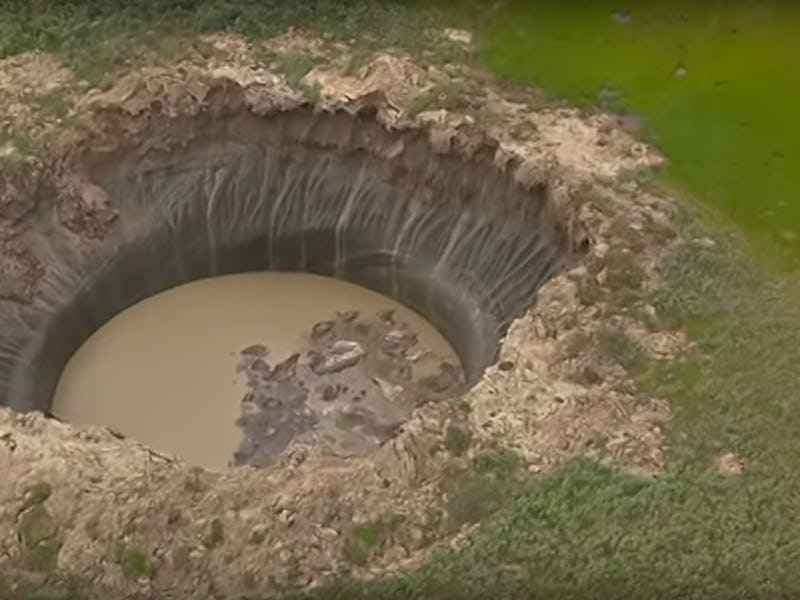7,000 Underground Gas Bubbles in Siberia Are About to Burst
Though the phenomena is a mystery, scientists are fairly certain of the culprit: climate change.

In Siberia, Russian scientists have mapped out 7,000 dirt-covered mounds, which have mysteriously taken shape in the otherwise flat tundra landscape. Some of them are slowly filling up with pressurized carbon dioxide and methane, and some of them are on the verge of exploding.
The finding was reported last week by TASS, a Russian news service, and comes after several giant craters suddenly surfaced on the Yamal Peninsula in the Kara Sea in 2014. Size estimates vary, although one of the craters is believed to be at least 300 feet across and maybe twice as deep.
The origin story behind the craters is shrouded in mystery, and the theories being floated are questionable at best. Initial reports stated that villagers heard an explosion from 60 miles away, and at least one person saw the sky light up (these accounts are unverified). Early speculation pointed to meteorites, secret military testing, and of course aliens.
The most credible hypothesis is less sinister. Carolyn Ruppel of the U.S. Geological Survey posited to National Geographic that a geological formation called a pingo collapsed suddenly, releasing a mass of natural gas that had been trapped under pressure below. It didn’t explode or burn up in flames; the gas bubbled to the surface as if it was in a pot of very thick simmering stew.
This version of events is supported by satellite imagery that shows pingos at the sites where the craters are now found. A pingo is a round hill that forms over a mound of icy soil, occurring in places where shallow permafrost lakes have drained away. The soil directly under a permafrost lake is not frozen, kept warm instead by the liquid water above. But when the lake drains, this pocket of soil freezes, and since ice takes up more space than water it bulges into a mound.
When the permafrost that makes up a pingo melts, it can collapse away into a crater, although before these examples in Siberia they were not known to form in such a dramatic way. But climate change could make this phenomenon a lot more common.
Permafrost is soil that is frozen year-round, and typically, it’s been that way for thousands of years. The frozen ground traps methane, preventing it from being released into the atmosphere. As the Arctic warms in response to climate change, though, permafrost is melting. It creates a feedback loop, since the melting permafrost releases greenhouse gases which contribute to more global warming.
Normally, the gases unlocked from the permafrost simply seep out of the ground and into the atmosphere. But in this part of Siberia, this isn’t always happening seamlessly, and deposits are accumulating underground.
Take these air pockets found recently in the same region underneath a field. These, too, are the result of methane released from permafrost below, and it seems that a thick mat of roots and grasses is slowing the gases so that they accumulate under the soil faster than they seep out. This is creating cushiony pockets that look very fun to jump on.
If the ice that makes the structure of a pingo melts and drains away, this could become a perfect reservoir for trapped gases beneath the soil to gather. As pressure builds up below and soil destabilizes from above, conditions ripen for the whole system to collapse in a very large belch.
What exactly happened when these craters formed is still a bit of a mystery, and scientists continue to investigate. And yet, the Russian government would rather be prepared the next time a giant chunk of earth suddenly falls away, releasing a large volume of flammable and potentially explosive gas.
That’s why they’re mapping the pingos across the landscape, although it’s yet unclear which are still frozen solid and which may be accumulating a store of pressurized methane. Once it’s known which mounds are dangerous, it will be possible to drill into them and release the gas before it blows. Which is too bad, really — in the name of science it would be a lot more interesting to wait and witness the cratering event first hand.